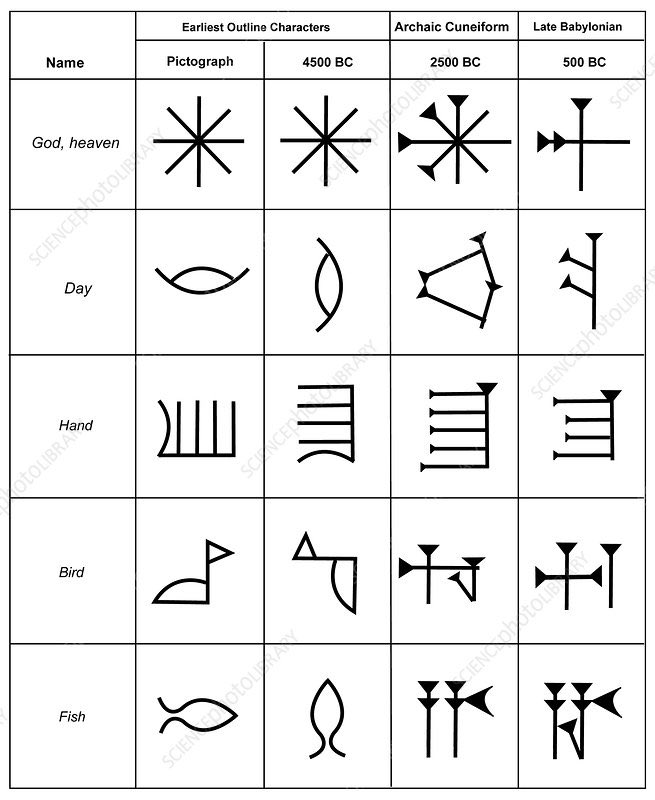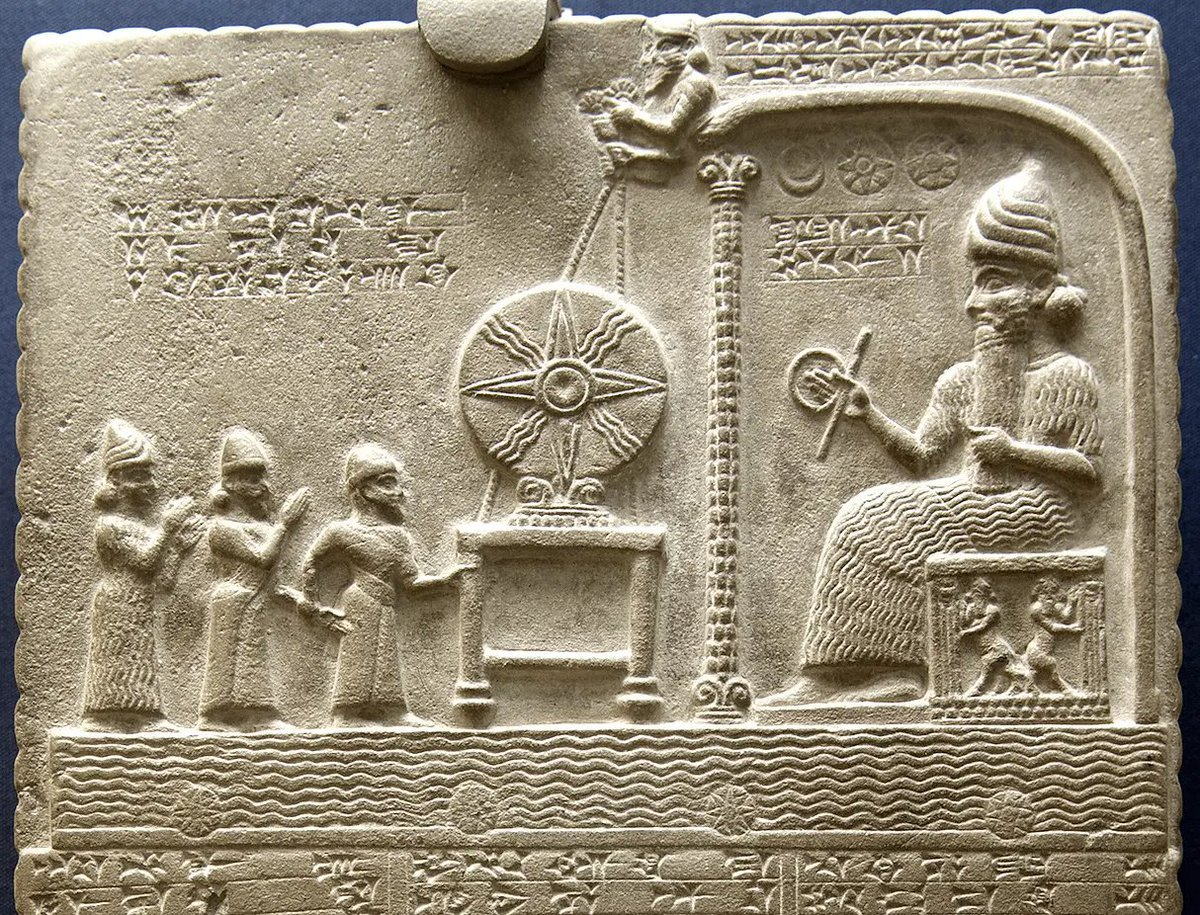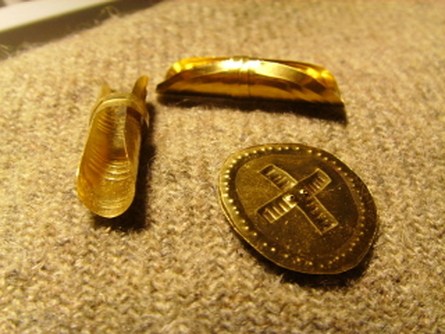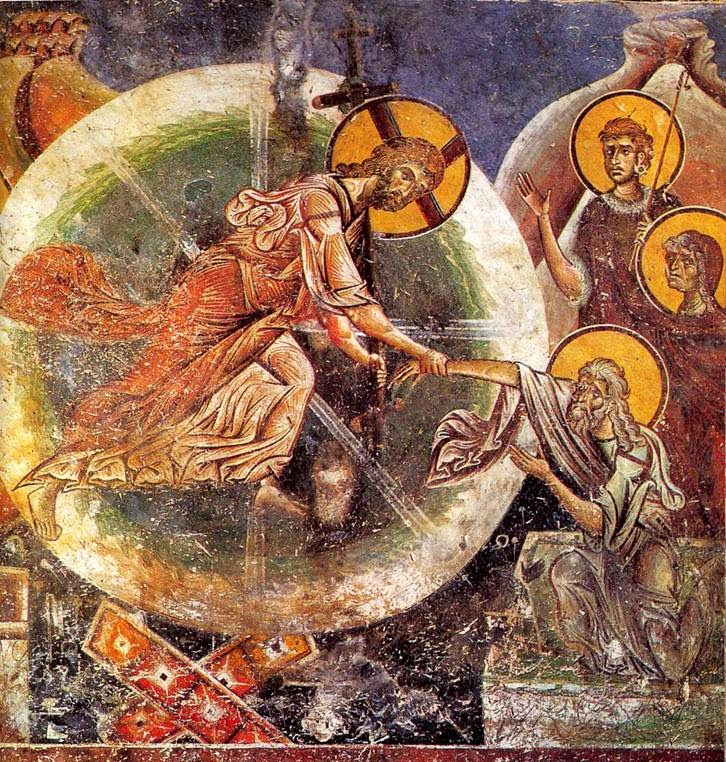Skull with plain amber discs on clay in eye-sockets Grave 275. Dated to the 4th millennium BC. Zvejnieki cemetery, Latvia. Researched by F. Zagorskis. Photo by A. Butrimas...
On the skulls with red ochre and clay round amber discs (sometimes rings) were found stuck intentionally into eye sockets as "replacements" for the eyes. In all those cases, the amber pieces have a large, centrally placed hole...
Obviously to resemble eyes...
The graves of the same culture also contained perforated amber disc with "sun cross" design...
Amber disc (obverse (sun cross), reverse (sun rays) and cross-section) from Daktariškė 5 Neolithic settlement...
In 1956 Eduard Šturms presented the first overview of Amber artefacts in Eastern Globular Amphora Culture and interpreted them as symbols of the sun and (male) sun god, as they were (apparently) found in men's graves...
All the researchers agree that amber was regarded as a "sun stone", because of its colour and the way it reflects light...
So, to me it is obvious that the perforated amber "sun" discs that were inserted into diseased eye sockets directly linked sun and sight...
I talked about the same idea here:
Utu, Sun: 𒀭𒌓
According to this table, this means god, heaven + day = sun...
Did the god sign originally mean shiny thing? Did the day sign originally mean "eye"?
If so: shiny thing + eye = to see = sun?
Like Slavic Svetovid = light + to see
I talked about this in my post "Svetovid"...
Now, check this out:
Irish "súil" (eye), from Old Irish súil (eye), from Proto-Celtic "sūle" ("two suns"), dual of "*sāwūl" (sun), from Proto-Indo-European "*sóh₂wl̥" (sun).
Officially: The change in meaning in Irish is apparently due to the mythological view of the sun as the "eye of the sky"...Or maybe because sun (light) gives us sight...
More info on amber sun discs can be found in this article...
This sun cross thing can explain this petroglyph The Sun in the ship. Rock engraving. Sweden (after R. Rimantienė)...
How? The sailing season in the Baltic Sea and White Sea starts in Apr/May...At the beginning of summer...I talked about this in my post "Bes", about petroglyphs from Lake Onega in Russia...
BTW, while the Globular Amphora guys were making their amber sun discs, the guys from Late Neolithic Vasagård archaeological site located on the southern side of the island of Bornholm, Denmark, were making these: sun stones...I talked about this in my post "Sun stones"...
Oh yeah, and guess who also had a cross as his symbol...Mesopotamian sun god...
This is the 860BC-850BC Middle Babylonian limestone "Sun God Tablet", currently in the British Museum.
And in this article, "Sun god tablet", I tried to add few bits of information that will help us understand some of the symbols depicted on this tablet...
Finally don't forget this...I almost did. I should have posted this right after the post about the eye-sun link in the Irish language...
Basalt Idol (?) depicting a humanoid figure with spiky hair (sun rays?) and torcs (gold lunula like this one from Ireland?) around the neck.
Ciudad Rodrigo, Spain. Early-Middle Bronze Age. Museo Archaeologico National in Madrid. Pic: Mark Vyvyan-Penney...I talked about the Irish gold sun bling in my post "Or Ireland's gold"...
I will talk more about sun crosses soon. Just discovered something interesting related to this on Malta...For people who are wondering why I omitted Bell Beakers and their golden sun crosses...
Almost forgot this. Christ as the sun-god Helios/Sol, 3rd c. AD, Vatican. Christ is born on Winter Solstice, (re)birth day of the sun (god), he enters Jerusalem on a donkey, "animal of the (sun) gods and kings", and gets put on a cross, symbol of the sun (god). Interesting. I talked about this in my post "Alexamenos graffito"...
Finally, I promise 🙂 According to Slavic folklore, west is where the entrance to the other(under)world is. Why? Cause this is where sun enters the other(under)world. Hmmm...Did the "sun disc eye for the dead" dudes also have a notion of this?
One of my favourite frescoes: Christ's descent into Hades, fresco from the 12th c. Church of St. George, Kurbinovo, Macedonia...Stunningly beautiful, it is also super unusual and interesting.
Article "Descending to Hades", about the Sun God as the ruler of the land of the dead.
















No comments:
Post a Comment